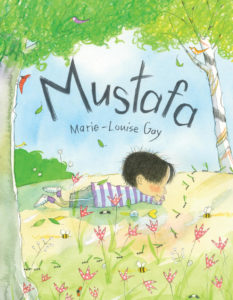January 18, 2019
Mr. Mergler, Beethoven, and Me, by David Gutnick and Mathilde Cinq-Mars
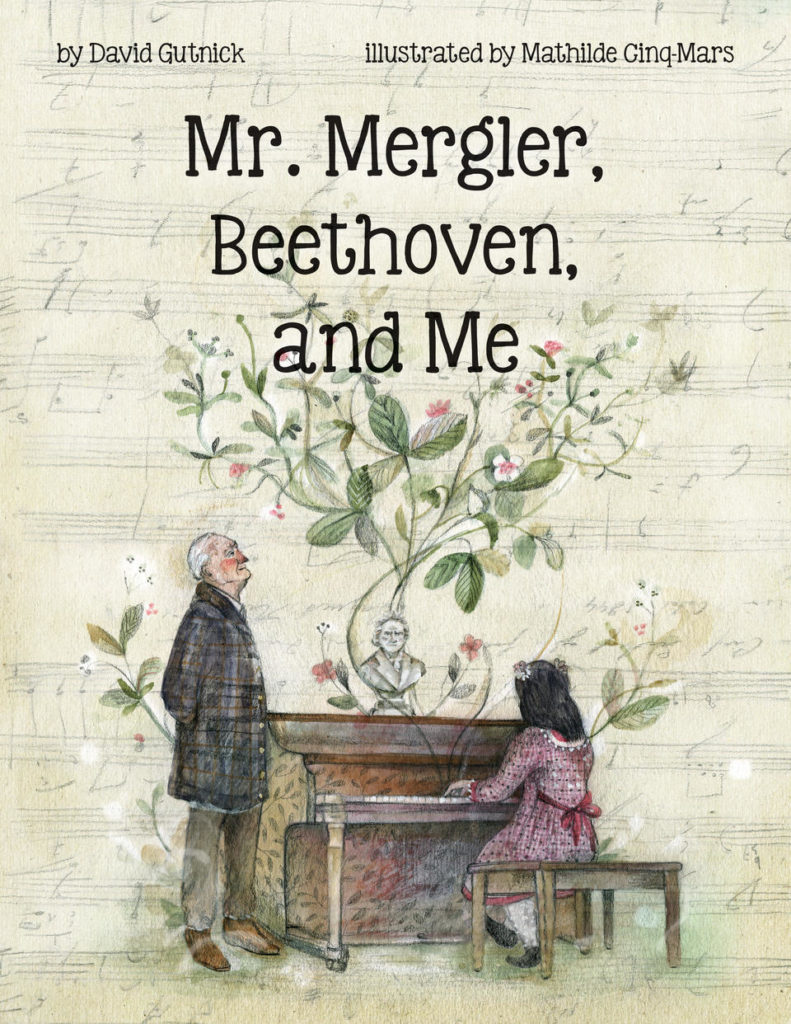
My youngest daughter feels she is on intimate terms with Ludwig van Beethoven, because he’s rendered as a cartoon character in her piano book, and while she’s never heard any of his music properly, she’s played several simple songs inspired by his music, and when we picked up Mr. Mergler, Beethoven, and Me, by David Gutnick and Mathilde Cinq-Mars, she was very impressed and excited to learn that other people know about him too.
David Gutnick is best known for his CBC Radio Documentaries, and his first book for children is inspired by one he created about the legacy of Montreal music teacher Daniel Mergler. The book begins with a young girl who has recently arrived from China whose family meets and elderly man in the park, and as the girl’s father and the man talk together, it is shared that the young girl has a talent for music and that the elderly man, Mr. Mergler, has taught piano for many years. Mr. Mergler agrees to take on the girl as a student, and is not concerned that her family does not have money to pay for lessons: “Something tells me that she understands the magic that music can bring to her life. If she does, that is all the payment I need.”
She begins attended classes at Mr. Mergler’s warm and cluttered studio, evocatively rendered in Cinq-Mars’ illustrations. On top of his piano there is a bust of Beethoven, and he’s scowling. When the girl manages to play her songs with no mistakes, however, she begins to wonder: “Was it my imagination, or did [Beethoven] look a little more friendly?”
Now I have written before about my household’s intolerance for books about death, no matter how much I try to infuse our reading with my own morbid nature. They’re having none of it. And so what is so very excellent about Mr. Mergler, Beethoven, and Me is that the music teacher’s death is handled in a way that is neither corny nor devastating, although the girl certainly is sad, of course. But Gutnick shows how Mr. Mergler’s spirit lives on in the gifts he gave his students, in their passion for music. It’s the most delicate balance, but Gutnick achieves it perfectly.
January 11, 2019
Deep Underwater, by Irene Luxbacher
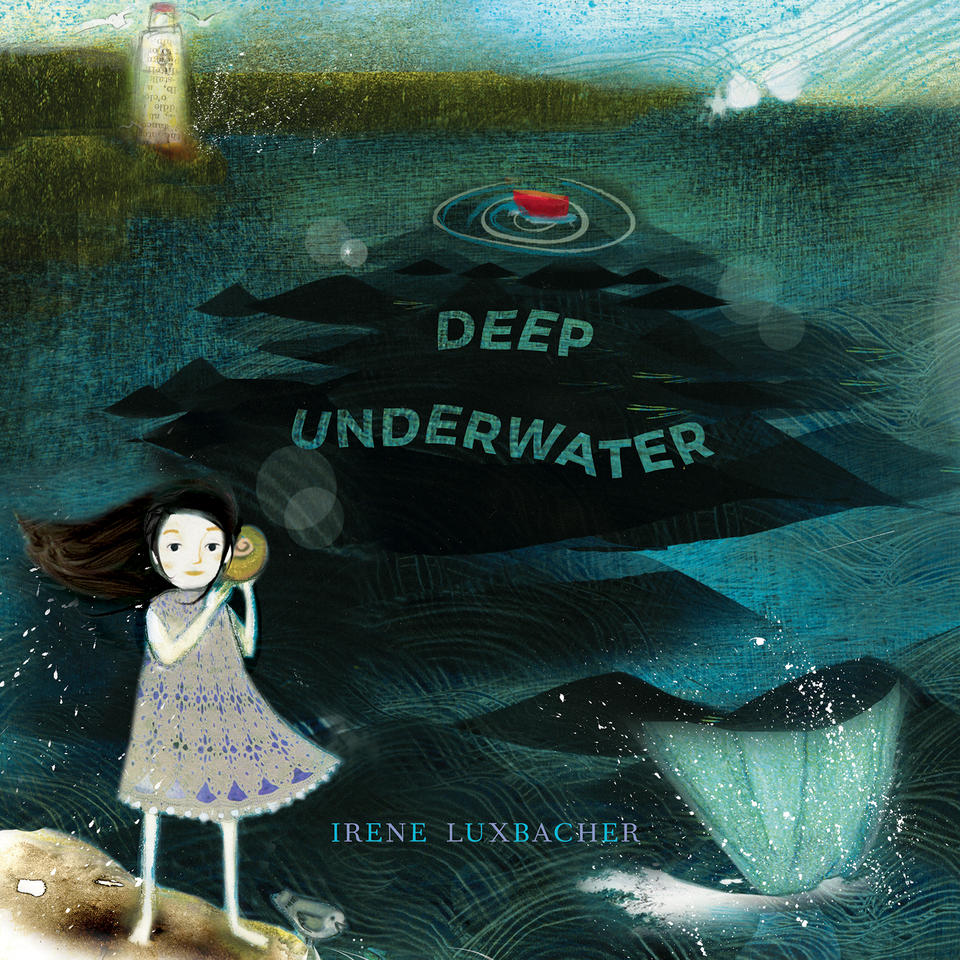
I love Irene Luxbacher’s playful collage illustrations, and they really shine in Deep Underwater, her latest picture book. Shine literally even, because the cover features sparkles. It’s the story of Sophia, who lives by the sea and knows its secrets, and takes the reader on a journey deep underwater to share what she knows. “Deep underwater, tentacles, antennae and teeth disappear into darkness…and an abyss becomes a bottomless pit of possibilities.” Full page spreads to get lost in, with urchins, and anemones, jellyfish and seahorses. Sea turtles, starfish, sardines, and a submarine. A sunken ship where “lost treasures wait silently, patiently hoping to be found.” Sophia tells us, “Deep down, I never feel alone,” contemplating her reflection in a handheld mirror, and we see the mermaid that she is in her mind, and really, who can’t relate?
December 14, 2018
Santa Never Brings me a Banjo, by David Myles
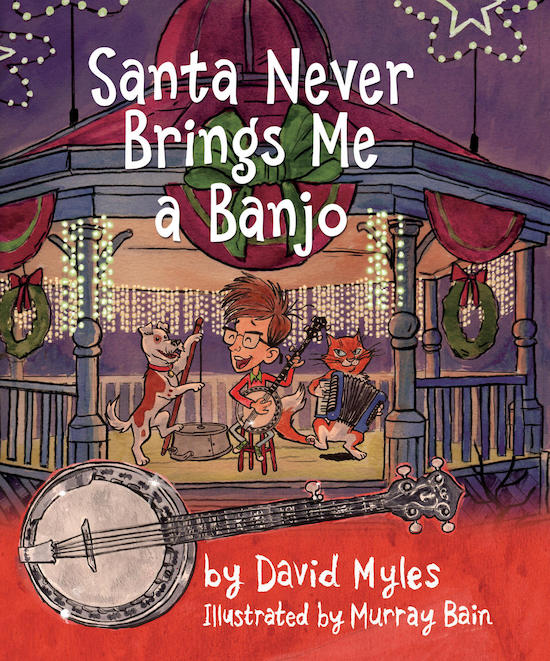
During The Most Wonderful Time of the Year, it can be easy to forget that Christmas is not a season of light for everybody, that those who are struggling can find the holidays particularly trying—and in his song-turned-picture book, Santa Never Brings Me A Banjo musician David Myles gives voice to one boy’s particular plight. Because, see, all he wants is a banjo, a simple request. And year after year, Santa fails to deliver, the boy’s hopes piqued by banjo-shaped packages that turn out to be something entirely different—a fishing net, a unicycle. But not a banjo to be had.
It’s a story of persistence, I suppose. We liked this book a lot and it’s made a great, non-cloying, and original addition to our Christmas library. A story of wanting and yearning and longing and the sweet anticipation of Christmas morning that has always been my favourite part of the season. It’s a story about one child’s love of music, and wishes finally coming true, and also a catchy melody that will get stuck in your head—with the music included, along with the chords. So you can play in on your banjo when all your dreams are realized.
December 7, 2018
Owls Are Good at Keeping Secrets, by Sara O’Leary and Jacob Grant
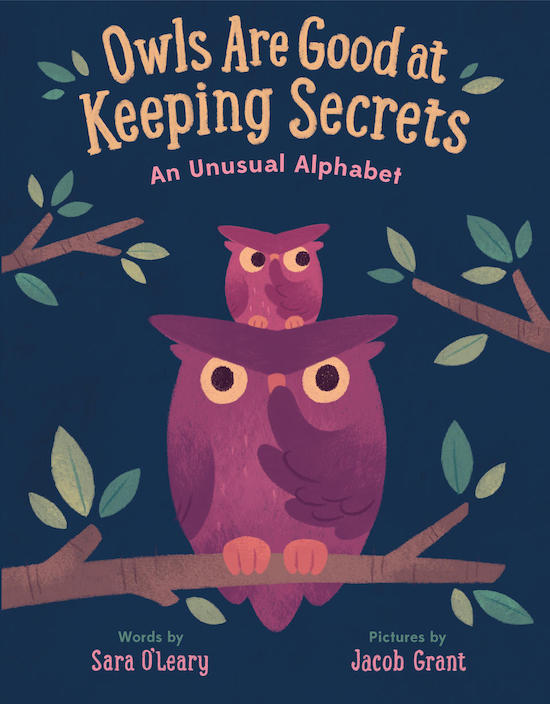
One of my favourite kids’ books this year, a book with a wonderful premise and an execution just as good, is Sara O’Leary’s latest picture book, illustrated by Jacob Grant, the fun, clever and adorable Owls Are Good at Keeping Secrets—and of course they are! It just makes perfect sense, along with “Elephants are happiest at bath time” and “Jellyfish don’t care if you think they look funny when they dance.” And Z is my very favourite of all the alphabetized animal facts appearing in this whimsical abecedary, but I’m not going to tell it here, because that would be a spoiler. Of course, “Raccoons are always the first to arrive for a party,” but did you know that “Narwhals can be perfectly happy all alone”? And just wait until you get to U, which I’m going to let you discover by yourself, but I’ll trust you’ll find it as delightful as I did. The whole thing is good, O’Leary’s pitch perfect character details enriched by Grant’s illustrations, which manage to be cute and stylish at once. Even those who know their ABCs are likely to find this book absolutely enchanting, so while it’s an excellent pick for a Christmas gift for that someone little on your list, it will go over well also for those who are a little bit taller.
November 30, 2018
The Zombie Prince and Mustafa
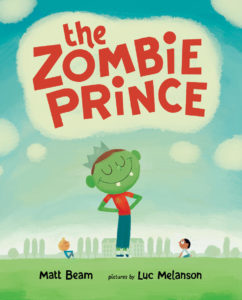 The Zombie Prince, by Matt Beam and Luc Melanson
The Zombie Prince, by Matt Beam and Luc Melanson
The first time we read The Zombie Prince, I was entranced by it, its puzzles and strangeness, how curiously it was framed, but the rest of my family weren’t so into it. “I didn’t get it,” they said, but I insisted, that this was a book that was special, that this was a book about boys and their feelings and the powers inherent in being sensitive. So we read it again, and they started to get it, liked the book as much as I do. I book that invites plenty of questions, which is why reading it again and again is worthwhile. “Why did Brandon tear up the flower?” I asked them tonight, and they speculated. This book isn’t breezy and is not a one-off, and runs the risk of being just a bit too subtle, but the illustrations are fun and appealing and the ideas of zombies and vampires are attractive enough to make a reader pick up the book a second time. This is a book with undercurrents, and the discerning reader will be able to put the pieces together. The discerning older reader will also be able to understand the implications of Brandon’s classmate having called him a “fairy,” and that this is a story with big implications. I appreciate its lack of obviousness, and that this is a book about boys and feelings that isn’t cheesy, or preachy. It’s expansive, like all the best books are, and isn’t afraid to ask its readers to think.
*
In her latest picture book, Marie-Louise Gay moves from her worlds of flying cats and a brother and sister in bucolic idylls to a different kind of reality, although it still comes with her characteristic whimsy. The title character in Mustafa is a young boy who has moved with his family away from an old country he still dreams of. “Dreams full of smoke and fire and load noises.” Lonely, he plays alone in the near near his new home, and takes in his new surroundings—shiny red bugs with black spots on their backs, trees whose leaves mysterious turn orange and red. “He sees two small animals jumping from branch to branch, They bushy tails wave and curl in the air. They chatter like monkeys.” There’s also a girl who walks a cat on a leash, and Mustafa is fascinated by all of it, but the girl in the particular because he fancies a friend. He asks his mother if perhaps he’s invisible. ‘”If you were invisible, I couldn’t hug you, could I?” answers his mama.’ But then one day the girl gestures for him to follow her, and they go together to watch fish in the pond. And Mustafa doesn’t feel invisible anymore, which makes for a really nice story about a refugee’s experience, but also an interesting exercise in seeing our homes from other people’s points of view, what we all look like from the outside, and how much it means to be invited in.
November 9, 2018
A World of Kindness
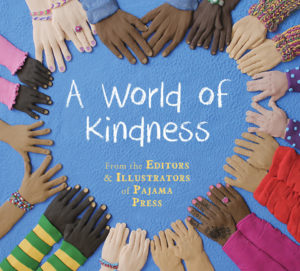 The superhero of my day today was the woman behind the counter of the Second Cup coffee shop where I was working this morning who engaged with every customer like she was happy to see them, who helped at least two elderly customers with fine motor tasks they were struggling with, and you could tell that for some people their conversations with her were the best parts of their days. She was just base level kind to everyone, and I thanked her for it when I finally left, because I liked the world a little bit better due to the fact that she was in it. Hers were little gestures, but they mean so much, and it’s how it all adds up that really matters, which is the point of a new picture book I love, A World of Kindness.
The superhero of my day today was the woman behind the counter of the Second Cup coffee shop where I was working this morning who engaged with every customer like she was happy to see them, who helped at least two elderly customers with fine motor tasks they were struggling with, and you could tell that for some people their conversations with her were the best parts of their days. She was just base level kind to everyone, and I thanked her for it when I finally left, because I liked the world a little bit better due to the fact that she was in it. Hers were little gestures, but they mean so much, and it’s how it all adds up that really matters, which is the point of a new picture book I love, A World of Kindness.
In a note inside the book, Pajama Press Publisher Gail Winskill writes that the idea for the book was born when her three-year-old granddaughter asked her one day, “Nana, how can I be kind?” Dedicated to the memories of Fred Rogers and Ernie Coombs (Misters Rogers and Dressup, respectively), the book has us to begin to contemplate that question, and makes some suggestion toward answers. “Do you wait your turn?/ Will you help someone younger…/or older?” Each page features art by Pajama Press’s acclaimed illustrators, some from previous books and others original (and my children were excited to see illustrations from books they’ve loved before!). Being gentle with animals, saying please and thank you, helping shy friends join in, watching over those who need it. “Will you be a friend to someone new?”
The ideas are simple, but they’re also transformative and profound, and the depth and diversity of illustrations on this book provide another layer of richness, making A World of Kindness a deeply meaningful read. Even better: royalties from the book will be donated to Think Kindness.
November 2, 2018
Dr. Jo, by Monica Kulling
 With her latest book Dr. Jo: How Sara Josephine Baker Saved the Lives of America’s Children, Monica Kulling continues to write fascinating (and often feminist!) biographies of remarkable figures who should be better known. We were huge fans of her Spic & Span, a biography of Lillian Gilbreth, who was not only the real-life mother of the Cheaper By the Dozen family, but she was also an efficiency expert, author, psychologist, industrial engineer, and inventor of the shelves inside your fridge door, the electric mixer AND the foot-pedal garbage can, which might make you wonder why all the books in the world aren’t about Lillian Gilbreth. But in the meantime, Dr. Sara Josephine Baker is worthy of a story of her own.
With her latest book Dr. Jo: How Sara Josephine Baker Saved the Lives of America’s Children, Monica Kulling continues to write fascinating (and often feminist!) biographies of remarkable figures who should be better known. We were huge fans of her Spic & Span, a biography of Lillian Gilbreth, who was not only the real-life mother of the Cheaper By the Dozen family, but she was also an efficiency expert, author, psychologist, industrial engineer, and inventor of the shelves inside your fridge door, the electric mixer AND the foot-pedal garbage can, which might make you wonder why all the books in the world aren’t about Lillian Gilbreth. But in the meantime, Dr. Sara Josephine Baker is worthy of a story of her own.
“People called Sara Josephine Baker a tomboy,” the book begins. “Jo did things that the quiet and polite girls of her day did not do…” From playing sports and skating on the Hudson River, to attending medical school—Jo’s interest in being a doctor underlined by the deaths of her father and brother from typhoid fever caused by a hospital dumping sewage in that same river. The importance of public health was also made apparent to Jo through these tragedies, and once she became a physician she realized that working as a health inspector would permit her to make an even greater difference. Kulling shows Jo working in Hell’s Kitchen in New York City, where disease spread quickly through tenement housing. And while the illustrations are cheerful and bright, the text doesn’t shy away from the realities of poverty and deprivation—Dr. Jo is called to a family whose baby dies of heatstroke, and another baby she visits has become blind from drops used to clear bacteria from its eyes. Kulling walks a perfect balance between message and story to deliver a picture book that readers of all ages will enjoy.
Kulling shows how Dr. Jo started the practice of licensing midwives to make births safe, organized stations where children could access clean milk, solved the problem of eye drops being contaminated with bacteria, and designed infant clothing that made for better temperature control. “Dr. Jo understood the connection between poverty and illness. Throughout her life she worked tirelessly to improve the health of women and their children in New York and other big cities.”
October 19, 2018
Africville, by Shauntay Grant and Eva Campbell
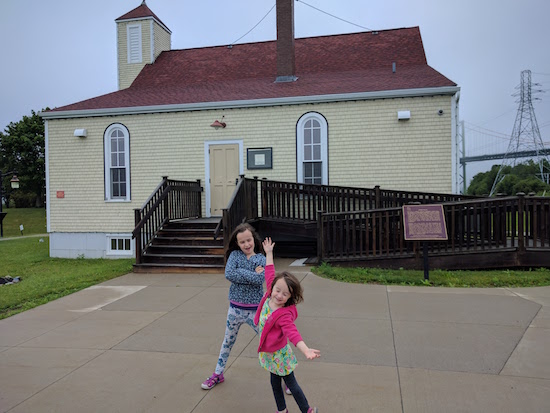
I am generally impressed with the search function for my online photos—if I search for “playground,” “Kensington Market,” or “bookstore,” it tends to have an uncanny sense of what I’m looking for, although it still has trouble telling the difference between a cup of tea and bowl of soup. But a search for “Africville” turned up nothing, a location Google didn’t recognize—which meant I had to go back into the archive and find the photo myself, the one of my children in front of the Africville Museum on our trip to Nova Scotia in 2017.
Which actually didn’t surprise me in the slightest, the history of Halifax’s historic Black community being one that’s not much about erasure, never mind that many of its residents could trace their roots back to the arrival of Black Loyalists in Canada during the American Revolutionary War. But while the community thrived in many ways, Africville’s residents never receive the same services as other taxpayers in the Halifax area, such as running water or sewage systems, and the municipality also saw fit to zone a garbage dump and slaughterhouses as its neighbours–all of which meant that when it became fashionable to condemn this historic Black community and recommend its demolition, there appeared to be plenty of reasons to support this action, and in the 1960s—against opposition—residents were moved out and the community was torn down.
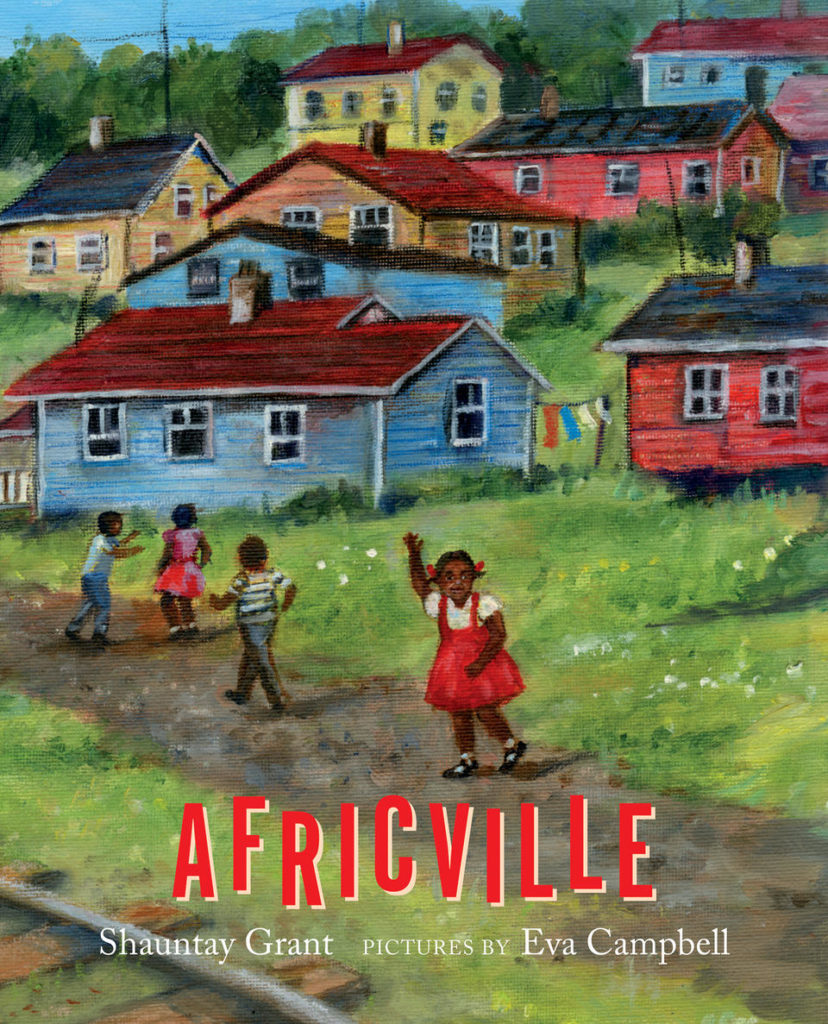
On the site now, a replica of the community’s church has been built as a museum, following the declaration of Africville as a National Historic Site of Canada in 2002. Our visit in 2017 was moving and informative, with a great scavenger hunt that got my children involved and engaged with the exhibits, and prompted important conversations about systemic racism and its historic legacies. But while there were books in the giftshop, there were no picture books about Africville exactly. Instead, we got Up Home, a beautiful book about another Nova Scotian Black community called North Preston, written by poet Shauntay Grant—whose The City Speaks in Drums we also picked up somewhere along the way, a perfect Halifax souvenir. All this meaning that I’ve been really looking forward to Grant’s latest release, Africville, a finalist for this year’s Governor-General’s Award for Children’s Literature, lyrically resonant and stunningly illustrated by Eva Campbell.
“Take me to the end of the ocean,” the book begins, “where waves come to rest and hug the harbour stones.” Africville reimagined in Campbell’s illustrations, oil and pastel on canvas, brightly coloured houses beside the bright blue sea. Blueberries growing on the hill, smells of apple pie and blueberry duff drifting from the kitchens. Football, rafting, and warm summer nights, “down at Kildare’s Field,/ a bonfire burning red/like the going-down sun.”
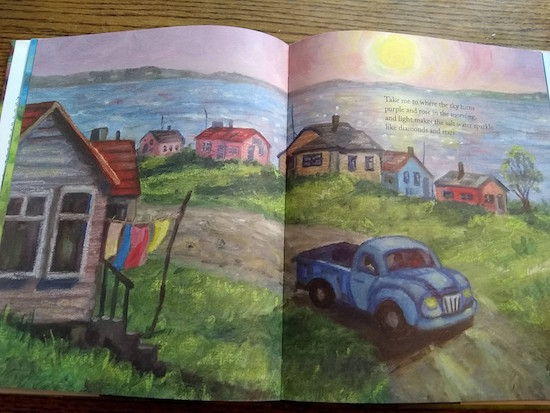
“Where the pavement ends and family begins.”
Through her story, Grant shows the resilience of Halifax’s Black community who wasn’t about to let their history disappear, and founded an annual Africville reunion festival in 1983, which continues years later and helped lead to the historic site declaration decades later. The rainbow houses are gone, but we see a stone marking the names of community families, and celebrations and singing inside the festival tent. “…where memories turn to dreams,/ and dreams turn to hope,/ and hope never ends. Take me…to Africville.” A history that’s erased no longer.
October 12, 2018
Picture Book Friday: The Crowd Pleasers Edition
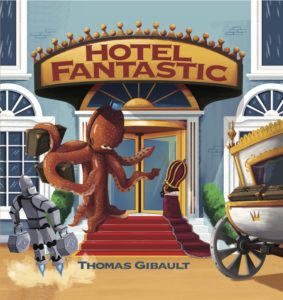 We’re pretty-obsessed with Hotel Fantastic, Thomas Gibeault’s picture book about a journey’s end that’s beyond your wildest imaginings. It’s a place like no other, indeed, providing a good night’s sleep to all sorts of creatures—dragons, robots, mermaids, monsters, and giants. There’s a gryphon in the gift shop and a Viking in the restaurant (where everything is roasted with dragon fire). There’s even a rooftop pool, and of course there is, because the Hotel Fantastic has everything, including a ballroom with a disco ball and an infirmary, and hotel security is a knight, a ninja, a superhero and a t-rex—but even they are no match for the PLOT TWIST that reaches in to the Hotel Fantastic at the end of the story and turns the whole thing on its nose. This book is an ode to play and unbounded imagination, as well as the realities of meddlesome siblings. Plus, Gibault’s illustrations are rich with colour and detail, drawing readers right in.
We’re pretty-obsessed with Hotel Fantastic, Thomas Gibeault’s picture book about a journey’s end that’s beyond your wildest imaginings. It’s a place like no other, indeed, providing a good night’s sleep to all sorts of creatures—dragons, robots, mermaids, monsters, and giants. There’s a gryphon in the gift shop and a Viking in the restaurant (where everything is roasted with dragon fire). There’s even a rooftop pool, and of course there is, because the Hotel Fantastic has everything, including a ballroom with a disco ball and an infirmary, and hotel security is a knight, a ninja, a superhero and a t-rex—but even they are no match for the PLOT TWIST that reaches in to the Hotel Fantastic at the end of the story and turns the whole thing on its nose. This book is an ode to play and unbounded imagination, as well as the realities of meddlesome siblings. Plus, Gibault’s illustrations are rich with colour and detail, drawing readers right in.
**
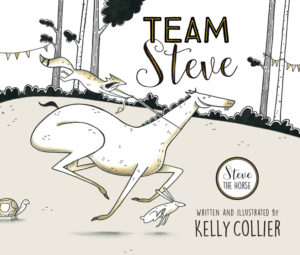 And Steve is back! We’re so excited. We loved Kelly Collier’s debut, A Horse Named Steve, and have been wondering what he’s been up lately, that loveable, self-obsessed equine. And so expectations were pretty high for Team Steve, her follow-up, but I’m pleased to announce that we heartily endorse it. And by “we,” I’m not being royal, but mean literally “we” with my team in picture book criticism, those without whom there would be no storytime, by husband and two children. We love Steve, who thinks he’s got the annual race-a-thon ALL TIED UP because he’s got the longest legs of all the creatures. Except now the rules have changed, and the race is a relay, and Steve’s on the team with Duck, Turtle and Snail. “Wait a sec,” says Steve. “A duck waddles, a turtle walks, and a snail…is a snail! How are we supposed to win?” But Steve, see, just literally can’t lose, no matter what he does, partly because this an unlikely tortoise and the hare-type story, but also because he’s got an ego as big as his heart is. This is a book with twists and turns (and plods and shuffles), and the ending was absolutely a delight.
And Steve is back! We’re so excited. We loved Kelly Collier’s debut, A Horse Named Steve, and have been wondering what he’s been up lately, that loveable, self-obsessed equine. And so expectations were pretty high for Team Steve, her follow-up, but I’m pleased to announce that we heartily endorse it. And by “we,” I’m not being royal, but mean literally “we” with my team in picture book criticism, those without whom there would be no storytime, by husband and two children. We love Steve, who thinks he’s got the annual race-a-thon ALL TIED UP because he’s got the longest legs of all the creatures. Except now the rules have changed, and the race is a relay, and Steve’s on the team with Duck, Turtle and Snail. “Wait a sec,” says Steve. “A duck waddles, a turtle walks, and a snail…is a snail! How are we supposed to win?” But Steve, see, just literally can’t lose, no matter what he does, partly because this an unlikely tortoise and the hare-type story, but also because he’s got an ego as big as his heart is. This is a book with twists and turns (and plods and shuffles), and the ending was absolutely a delight.
October 8, 2018
The Reptile Club, and other great books
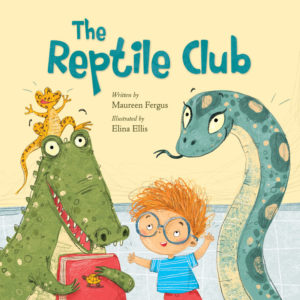 In lieu of a Picture Book Friday post, check out my round-up of great picture books for autumn—which includes the absolutely delightful The Reptile Club, by Maureen Fergus and Elina Ellis.
In lieu of a Picture Book Friday post, check out my round-up of great picture books for autumn—which includes the absolutely delightful The Reptile Club, by Maureen Fergus and Elina Ellis.
